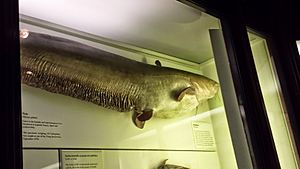Tring Reservoirs facts for kids
| Site of Special Scientific Interest | |

Startops End Reservoir
|
|
| Area of Search | Hertfordshire Buckinghamshire |
|---|---|
| Grid reference | |
| Interest | Biological |
| Area | 106.5 hectares |
| Notification | 1987 |
| Location map | Magic Map |
Tring Reservoirs is a group of four large lakes. They are located near the town of Tring in England. These reservoirs are right on the border between Hertfordshire and Buckinghamshire. Their main job is to feed water into the Grand Union Canal. This canal is a long waterway used by boats.
The four reservoirs are called Startops End, Marsworth, Tringford, and Wilstone. Startops End, Marsworth, and Tringford are all connected. Only paths and roads separate them. Wilstone Reservoir is a short distance away. It is close to the village of Wilstone.
These reservoirs are very important for nature. They cover a huge area of about 106.5 hectares. That's like 263 football fields! Because they are so special for wildlife, they are protected. They are known as a biological Site of Special Scientific Interest. The Herts and Middlesex Wildlife Trust helps to look after them.
Contents
History of Tring Reservoirs
The Tring Reservoirs were built a long time ago. They were made to supply water to the Grand Union Canal.
- Wilstone Reservoir is the biggest of the four. It covers about 119 acres. It was built in 1802. This reservoir can be up to 18 feet deep. It holds a huge amount of water. Wilstone Reservoir sends water to the Wendover arm of the Grand Union Canal.
- Startops End Reservoir was built in 1817. It is much smaller, covering about 26 acres.
- Marsworth Reservoir was built in 1806. It is about 24 acres in size.
- The smallest, Tringford Reservoir, was built in 1816.
Amazing Bats at Tring Reservoirs
Tring Reservoirs are home to many bats! Bats love this area because there are so many insects for them to eat.
- Pipistrelle bats live here. These tiny bats are only about 4 cm long. They weigh just 5 grams, which is like two pennies! But they can eat around 3,000 insects every night.
- Brandt's bats have been found at Wilstone Reservoir.
- The Noctule is another bat species here. It is one of Britain's larger bats.
- Daubenton's bats are also seen. They fly very low over the water. They skim the surface to catch insects like caddis flies.
You are most likely to see bats after the sun sets. Look for them on warm evenings during the summer.
Wonderful Birds of Tring Reservoirs
Wilstone Reservoir is a very important place for wildfowl. Many rare birds live here. Other birds also live on the other three reservoirs.
Some of the birds you might spot include:
- Large birds like Canada geese, Egyptian geese, greylag geese, and mute swans.
- Water birds such as great crested grebes, little grebes, common coots, and common moorhens.
- Ducks like mallards, tufted ducks, shovelers, and Mandarins.
- Wading birds like common sandpipers, green sandpipers, common snipes, and lapwings.
- Birds of prey such as marsh harriers, hobbys, ospreys, and peregrine falcons.
- Many smaller birds like blue tits, nuthatches, kingfishers, and different types of warblers.
This area is a fantastic place for birdwatching!
Paths and Towpaths for Exploring
There are many paths around the reservoirs. You can also walk along the canal towpaths. This means there are lots of places to explore and enjoy the outdoors.
Fishing Fun at Tring Reservoirs
The Tring Reservoirs are very popular with people who love to fish. They are famous for having some really big fish! Some of these fish have even broken British records.
- Wels catfish weighing up to 60 pounds have been caught here. A British record wels catfish of 43 pounds 8 ounces was caught by Richard Bray at Wilstone Reservoir in 1970.
- Carp weighing up to 35 pounds can be found.
- Tench weighing up to 14 pounds have been caught. The British record for tench was broken twice at Wilstone Reservoir! Tony Chester caught a 10-pound 1-ounce tench in 1981. Then, Alan Wilson caught a 12-pound 8-ounce tench in 1985.
- Pike up to 20 pounds live in the reservoirs.
- Bream up to 17 pounds have been caught. The British record for bream was broken twice at Startops End Reservoir. Mr. A.J Fisher caught a 12-pound 12-ounce bream in 1931. C.J.Pugh then broke that record with a 12-pound 14-ounce bream in 1933.
- The current British record for Perch was caught at Wilstone Reservoir. Ken Brown caught a 6-pound 3-ounce perch on September 18, 2012.
- You can also find roach and rudd up to 2 pounds.
- Rainbow trout are put into Tringford Reservoir. This is just for fly fishing.
Gallery





